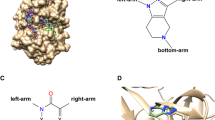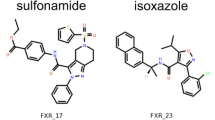Abstract
We participated in Subchallenges 1 and 2 of the Drug Design Data Resource (D3R) Grand Challenge 3. To prepare our submissions, we performed molecular docking with UCSF DOCK 6 and binding potential of mean force (BPMF) calculations—free energy calculations between flexible ligands and rigid receptors—using our open-source software package Alchemical Grid Dock (AlGDock). For each system, submissions were based on the minimum BPMF calculated for a selected set of crystal structures. In Subchallenge 1, our workflow performed poorly. Possible reasons for the poor performance include the neglect of cooperative ligands and limited sampling of ligand binding poses. In Subchallenge 2, our workflow led to some of most highly correlated submissions (Pearson R = 0.5) for vascular endothelial growth factor receptor 2. However, our results were poorly correlated for Janus Kinase 2 and Mitogen-activated protein kinase 14. Affinity prediction could potentially be improved by systematic selection of more diverse receptor configurations.


Similar content being viewed by others
References
D3R 2018 workshop (2018) https://drugdesigndata.org/about/d3r-2018-workshop
Wang W, Kollman PA (2000) Free energy calculations on dimer stability of the HIV protease using molecular dynamics and a continuum solvent model. J Mol Biol 303:567–582
Swanson JMJ, Henchman RH, McCammon JA (2004) Revisiting free energy calculations: a theoretical connection to MM/PBSA and direct calculation of the association free energy. Biophys J 86:67–74
Hou T, Wang J, Li Y, Wang W (2011) Assessing the performance of the mm/pbsa and mm/gbsa methods. 1. The accuracy of binding free energy calculations based on molecular dynamics simulations. J Chem Inf Model 51:69–82
Genheden S, Ryde U (2015) The MM/PBSA and MM/GBSA methods to estimate ligand-binding affinities. Expert Opin Drug Discov 10:449–461
Wang L, Wu Y, Deng Y, Kim B, Pierce L, Krilov G, Lupyan D, Robinson S, Dahlgren MK, Greenwood J, Romero DL, Masse C, Knight JL, Steinbrecher T, Beuming T, Damm W, Harder E, Sherman W, Brewer M, Wester R, Murcko M, Frye L, Farid R, Lin T, Mobley DL, Jorgensen WL, Berne BJ, Friesner RA, Abel R (2015) Accurate and reliable prediction of relative ligand binding potency in prospective drug discovery by way of a modern free-energy calculation protocol and force field. J Am Chem Soc 137:2695–2703
Gilson MK, Given JA, Bush BL, McCammon JA (1997) The statistical-thermodynamic basis for computation of binding affinities: a critical review. Biophys J 72:1047–1069
Minh DDL (2012) Implicit ligand theory: rigorous binding free energies and thermodynamic expectations from molecular docking. J Chem Phys 137:104,106
Nguyen TH, Minh DDL (2018) Implicit ligand theory for relative binding free energies. J Chem Phys 148:104,114
Pattabiraman N, Levitt M, Ferrin TE, Langridge R (1985) Computer graphics in real-time docking with energy calculation and minimization. J Comput Chem 6:432–436
Meng EC, Shoichet BK, Kuntz ID (1992) Automated docking with grid-based energy evaluation. J Comput Chem 13:505–524
Minh DDL (2018) Power transformations improve interpolation of grids for molecular mechanics interaction energies. J Comput Chem (in press)
Minh DDL (2015) Protein-ligand binding potential of mean force calculations with Hamiltonian replica exchange on alchemical interaction grids. arXiv
Minh DDL (2017) AlGDock. https://github.com/CCBatIIT/AlGDock
Jiang W, Roux B (2010) Free energy perturbation Hamiltonian replica-exchange molecular dynamics (FEP/H-REMD) for absolute ligand binding free energy calculations. J Chem Theory Comput 6:2559–2565
Wang K, Chodera JD, Yang Y, Shirts MR (2013) Identifying ligand binding sites and poses using GPU-accelerated Hamiltonian replica exchange molecular dynamics. J Comput-Aided Mol Des 27:989–1007
Lapelosa M, Gallicchio E, Levy RM (2012) Conformational transitions and convergence of absolute binding free energy calculations. J Chem Theory Comput 8:47–60
Nguyen TH, Zhou HXX, Minh DDL (2018) Using the fast Fourier transform in binding free energy calculations. J Comput Chem 39:621–636
Xie B, Nguyen TH, Minh DDL (2017) Absolute binding free energies between T4 lysozyme and 141 small molecules: calculations based on multiple rigid receptor configurations. J Chem Theory Comput 13:2930–2944
Hartshorn MJ, Verdonk ML, Chessari G, Brewerton SC, Mooij WTM, Mortenson PN, Murray CW (2007) Diverse, high-quality test set for the validation of protein-ligand docking performance. J Med Chem 50:726–741
Eswar N, Webb B, MartiRenom MA, Madhusudhan MS, Eramian D, Shen M, Pieper U, Sali A (2007) Comparative protein structure modeling using MODELLER. Curr Protoc Protein Sci 50:2.9.1–2.9.31
Consortium TU (2017) UniProt: the universal protein knowledgebase. Nucleic Acids Res 45:D158–D169
Bakan A, Meireles LM, Bahar I (2011) ProDy: Protein dynamics inferred from theory and experiments. Bioinformatics 27:1575–1577
Oliphant TE (2007) Python for scientific computing. Comput Sci Eng 9:10–20
Wang J, Wolf RM, Caldwell JW, Kollman PA, Case DA (2004) Development and testing of a general amber force field. J Comput Chem 25:1157–1174
Case D, Cerutti D, TE Cheatham I, Darden T, Duke R, Giese T, Gohlke H, Goetz A, Greene D, Homeyer N, Izadi S, Kovalenko A, Lee T, LeGrand S, Li P, Lin C, Liu J, Luchko T, Luo R, Mermelstein D, Merz K, Monard G, Nguyen H, Omelyan I, Onufriev A, Pan F, Qi R, Roe D, Roitberg A, Sagui C, Simmerling C, Botello-Smith W, Swails J, Walker R, Wang J, Wolf R, Wu X, Xiao L, York D, Kollman P (2017) AMBER 2017. University of California, San Francisco. http://ambermd.org/CiteAmber.php
Jakalian A, Bush BL, Jack DB, Bayly CI (1999) Fast, efficient generation of high-quality atomic charges. AM1-BCC model: I. Method. J Comput Chem 21:132–146
Jakalian A, Jack DB, Bayly CI (2002) Fast, efficient generation of high-quality atomic charges. AM1-BCC model: II. Parameterization and validation. J Comput Chem 23:1623–1641
Dolinsky TJ, Nielsen JE, McCammon JA, Baker NA (2004) PDB2PQR: an automated pipeline for the setup of Poisson-Boltzmann electrostatics calculations. Nucleic Acids Res 32:665–667
Lang P, Brozell SR, Mukherjee S, Pettersen E, Meng EC, Thomas V, Rizzo RC, Case DA, James T, Kuntz ID (2009) DOCK 6: combining techniques to model RNA-small molecule complexes. RNA 15:1219–1230
Pettersen EF, Goddard TD, Huang CC, Couch GS, Greenblatt DM, Meng EC, Ferrin TE (2004) UCSF Chimera—a visualization system for exploratory research and analysis. J Comput Chem 25:1605–1612
Feenstra KA, Hess B, Berendsen HJC (1999) Improving efficiency of large time-scale molecular dynamics simulations of hydrogen-rich systems. J Comput Chem 20:786–798
Hopkins CW, Le Grand S, Walker RC, Roitberg AE (2015) Long-time-step molecular dynamics through hydrogen mass repartitioning. J Chem Theory Comput 11:1864–1874
Onufriev A, Bashford D, Case DA (2004) Exploring protein native states and large-scale conformational changes with a modified generalized Born model. Proteins Struct Funct Bioinf 55:383–394
Bakan NA, Sept D, Joseph S, Holst MJ, McCammon JA (2001) Electrostatics of nanosystems: application to microtubules and the ribosome. Proc Natl Acad Sci 98:10037–10041
Duane S, Kennedy AD, Pendleton BJ, Roweth D (1987) Hybrid Monte Carlo. Phys Lett B 195:216–222
Phillips JC, Braun R, Wang W, Gumbart J, Tajkhorshid E, Villa E, Chipot C, Skeel RD, Kalé L, Schulten K (2005) Scalable molecular dynamics with NAMD. J Comput Chem 26:1781–1802
Abagyan R, Totrov M, Kuznetsov D (1994) ICM—a new method for protein modeling and design: applications to docking and structure prediction from the distorted native conformation. J Comput Chem 15:488–506
Totrov M (2007) Atomic property fields: generalized 3D pharmacophoric potential for automated ligand superposition, pharmacophore elucidation and 3D QSAR. Chem Biol Drug Des 71:15–27
Huang SY, Zou X (2011) Statistical mechanics-based method to extract atomic distance-dependent potentials from protein structures. Proteins Struct Funct Bioinf 79:2648–2661
Koes DR, Baumgartner MP, Camacho CJ (2013) Lessons learned in empirical scoring with SMINA from the CSAR 2011 benchmarking exercise. J Chem Inf Model 53:1893–1904
Pordes R, Petravick D, Kramer B, Olson D, Livny M, Roy A, Avery P, Blackburn K, Wenaus T, Würthwein F, Foster I, Gardner R, Wilde M, Blatecky A, McGee J, Quick R (2007) The open science grid. J Phys: Conf Ser 78:012–057
Acknowledgements
We thank OpenEye scientific software for providing a free academic license. This research was supported by the National Institutes of Health (R15GM114781). Calculations were performed on the Open Science Grid [42] as well as a computing cluster managed by Illinois Tech.
Author information
Authors and Affiliations
Corresponding author
Electronic supplementary material
Below is the link to the electronic supplementary material.
Rights and permissions
About this article
Cite this article
Xie, B., Minh, D.D.L. Alchemical Grid Dock (AlGDock) calculations in the D3R Grand Challenge 3. J Comput Aided Mol Des 33, 61–69 (2019). https://doi.org/10.1007/s10822-018-0143-9
Received:
Accepted:
Published:
Issue Date:
DOI: https://doi.org/10.1007/s10822-018-0143-9




